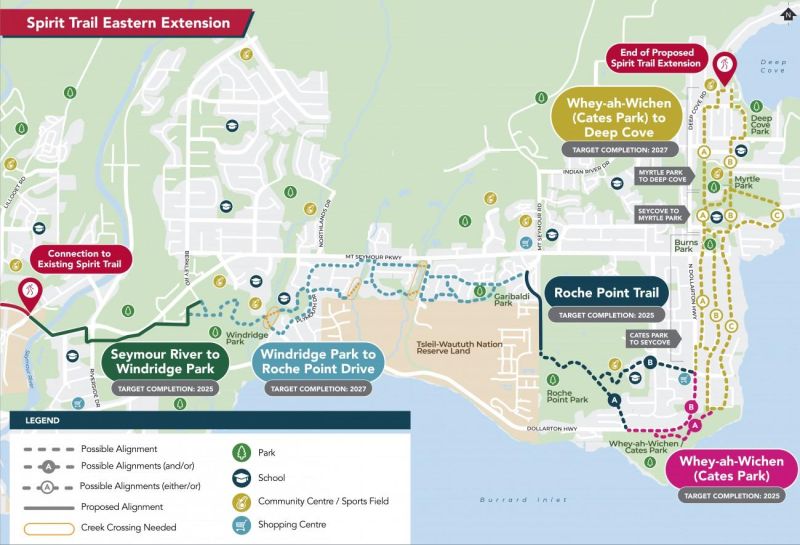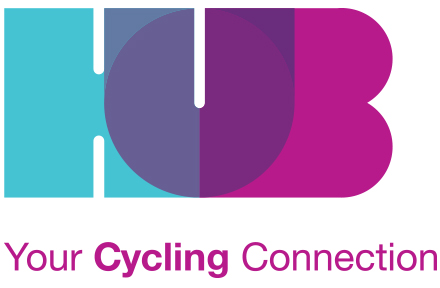URGENT ACTION REQUIRED: Support the North Shore Spirit Trail - Eastern Extension

March 4, 2024
Winding its way along our scenic waterfront and through forested neighbourhoods, the North Shore Spirit Trail is a fully accessible 35km greenway that will tie communities together from Horseshoe Bay to Deep Cove. The most extended existing segment runs from Ambleside, through Lonsdale Quay to Park and Tilford.
The District of North Vancouver hosted a public information session on February 21 to share information about expanding the trail to provide a continuous active transportation connection linking key destinations and neighbourhoods from Ambleside to Deep Cove.
Your voice matters. In the recent public engagement session regarding the proposed Spirit Trail, we heard some points of dissent. Some concerns were valid, reflecting the diversity of opinions in our community. However, it's essential to remember that constructive criticism should not overshadow the potential benefits this project could bring to the wider North Shore community.
How can you show your support?
1. Attend the next information session on Wed, March 6th: The District of North Vancouver will be hosting its next information session on Wednesday, March 6, from 6 pm – 8 pm at Kenneth Gordon Maplewood Elementary School Gymnasium, 420 Seymour River Place.
2. Use the following points of information to create an email to or to speak with others about the benefits of the Spirit Trail:
In writing your letter, be sure to personalize it with your own experiences, perspectives, and reasons for supporting the Spirit Trail. Whether you're a parent looking forward to family bike rides, a nature enthusiast eager to explore new trails, or a business owner excited about potential economic growth, your voice adds depth and authenticity to the conversation.
Send your email to the council at council@dnv.org.
What is the proposed Maplewood to Deep Cove Spirit Trail Extension?
From Park and Tilford, people can use other paths to get to the Superstore on the border of Maplewood. From there, the options are limited to the Dollarton Highway and Mount Seymour Parkway. The District has proposed a route south of Mount Seymour Parkway as it presents the best opportunity to connect more neighborhoods and destinations. It is important to know that the specific routing for most segments is not set yet. In other locations, a proposed route is shown as there are limited options.
How much will the Spirit Trail Extension cost?
Due to the many people expressing their support in 2023, the District responded by not cutting Spirit Trail money from the budget and supporting a five-year, $20 M implementation. The District has committed $10 M, while the province's Growing Communities Fund has provided a further $10 M. In contrast, the new Highway 1 Lower Lynn Improvements project cost $198 M.
Does the Spirit Trail Extension address safety and equity concerns?
There is currently no safe, family-oriented bike route or walking path between Maplewood and Deep Cove. The Spirit Trail will link multiple schools, giving children a safe route to walk or bike, providing them with a degree of independence, and encouraging them to exercise. There are multiple facilities for people in vehicles to reach their eastern destinations, but walking or biking along those same routes is downright scary or at least very unpleasant. People wanting to walk or ride in this area have no options. Our Official Community Plan sets out to make transit and active transportatin 35% of all trips. With no options for comfortable travel, people walking and cycling have no equitable access to their preferred mode of transport.
What is the importance of a commuter route vs. a recreational path?
The bike lanes along Mount Seymour Parkway are viewed as a commuter route for people who are comfortable riding on busy thoroughfares. In contrast, the Spirit Trail is viewed as a path for connecting communities and encouraging people to walk and ride for recreation and transportation. It will be a quieter, more meandering route. People currently intimidated by riding on Mount Seymour Parkway will likely use the Spirit Trail as a slower-speed transportation corridor. You can relax and enjoy the ride free from fast-moving, heavy vehicles.
How can the Spirit Trail extension help connect our community?
The people who may benefit from the trail most are those who live along it - now, and in the future, which in the long run can improve property values. Multi-use paths are not simply infrastructure for recreation and transportation. Linear parks like the Spirit Trail are integral to their host neighbourhoods. Why? Locals are by far the heaviest users of multi-use paths. The pace of life slows down on a multi-use path. Stop for a bit to watch a woodpecker or pick huckleberries. Teach your granddaughter to ride her new pushbike. Stop to pet your neighbor’s dog and talk about – well, other neighbours, of course. Even if you don’t stop to chat, at the slow pace of walking and riding, you can at least make eye contact, smile, say hi, and move along with a sense of optimism that the world is good.
How will the Spirit Trail Extension impact host neighbourhoods?
Will this increase vehicle traffic at trailheads?
People living along the proposed route are naturally concerned about the potential for increased car traffic and non-resident parking. Unlike the Hyannis area in Blueridge, the streets proposed for the neighborhood bikeway portions of the Spirit Trail will not be “trailheads' ' so any moving or parked vehicle increase should be small. Non-local trail users will likely park in the Superstore lot to access the trail in the West and the Parkgate and Myrtle Park lots in the East. They are not likely to park in the “middle” of a route.
Will residential vehicle parking be removed?
Using a “neighbourhood bikeway” design on already quiet streets with low traffic volumes means parking removal will be mostly unnecessary. In addition, small parklets may pop up along the route, creating places for people to relax in their neighborhood.
Will this extension create increased conflicts with roadway users?
In other areas where bike routes run along residential streets, the increased number of people walking and rolling has not led to a marked increase in conflicts between people in vehicles. A good example of a neighborhood bikeway is along 15th Street in the Norgate Area.
Will this extension increase street safety?
To make the route safe for people walking and cycling, the District will include measures to ensure local traffic speeds are low. This will benefit residents living along the route, reducing speeding, noise, and emissions in your neighbourhood, and making the streets safer for people on foot - such as children and young families.
How will the Spirit Trail Extension address Deep Cove's Capacity Challenges?
Deep Cove is a space-constrained neighbourhood. There isn't enough parking, or frequent enough transit service for everyone who wants to visit Deep Cove. Allowing people on wheels or on foot to get to Deep Cove from points west will alleviate the congestion this neighbourhood experiences in high season. More people arriving using transportation that does not emit greenhouse gases keep our wonderful forest air clean.
Thanks for reading. We appreciate your enthusiasm and interest in the Spirit Trail!
Sincerely,
